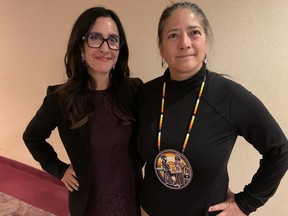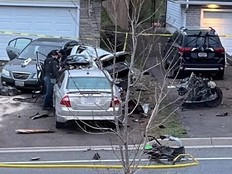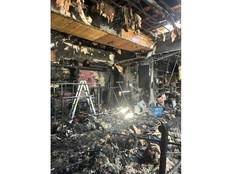Analysis: What’s at stake in the motions to strike privately held land?
Over the ensuing centuries, the Crown has continued to grant fee-simple titles to third parties (1759-2024) and that is why the Wolastoqiyik’s extension of Aboriginal title to privately held lands is so problematic.

Article content
The Court of Kings Bench is presently hearing several preliminary motions tied to the ongoing litigation over the claim to Aboriginal title brought by New Brunswick’s six Wolastoqey First Nations. While the parties’ written submissions are voluminous, the moving parties seek the same outcome: an order striking key aspects of the statement of claim. One is of particular interest to the public at large.
Collectively, the moving parties seek to strike the declaration of Aboriginal title as it applies to privately owned lands, commonly referred to as “fee-simple” lands. Should the motions succeed, the declaration will be restricted to Crown lands. What follows is a primer to the underlying issues and the significance of the litigation to both the Indigenous and non-Indigenous people of New Brunswick.
No one was surprised when the Wolastoqiyik announced the filing of a lawsuit seeking a declaration of Aboriginal title to their “traditional lands.” What was surprising was the breadth of the claim: more than 4 million hectares of land – 60 per cent of the province – embracing 283,204 parcels with an assessed value of more than $44 billion.
Yet the significance of those numbers was immediately overshadowed by another reality: the claim was not restricted to Crown lands. Privately held lands were included. That claim alone accounted for 252,758 of the 283,204 parcels.
The extension of the title claim to privately owned lands attracted public attention, and for good reason. To date, all of the Supreme Court cases have dealt with Aboriginal title over Crown lands. A snapshot of the jurisprudence must suffice.
The Supreme Court has never been asked to address a simple but fundamental question of law: Does a claim of Aboriginal title, based on pre-sovereignty occupation, extend to privately owned lands?
It was not until the case Calder v British Columbia (AG), decided in 1973, that the Supreme Court of Canada began to acknowledge Aboriginal title as a right flowing from prior occupation of land by an Aboriginal group prior to European colonization. Over time, the Supreme Court confirmed that Aboriginal title may be established in one of two ways: 1) by agreement or treaties, or 2) by establishing “exclusive occupation”of the claimed lands prior to the assertion of British sovereignty. In New Brunswick, the applicable date is 1759.
It is interesting to note the Wolastoqiyik have not invoked the Peace & Friendship treaties, signed between 1725 and 1761, as an independent source of Aboriginal title. The treaties are simply referred to as evidence their traditional lands were never ceded. Thus, the onus rests on the Indigenous plaintiffs to establish, at trial, exclusive occupation of the claimed area as of 1759.
Over the ensuing centuries, the Crown has continued to grant fee-simple titles to third parties (1759-2024) and that is why the Wolastoqiyik’s extension of Aboriginal title to privately held lands is so problematic. Doing so generates an immediate conflict between the rights of the Indigenous plaintiff and the defendant owner of fee-simple lands. Should a court affirm a declaration of Aboriginal title, both would possess the exclusive right to use and occupy the land.
Common sense dictates that the interests of one title holder must prevail over the other.
Importantly, a declaration of Aboriginal title is not the equivalent of a fee-simple deed to land. There are substantive differences between the two and those differences are relevant to the argument that Aboriginal title cannot embrace privately held lands. I focus only on similarities.
Since 1973, the Supreme Court of Canada has gone about its business of articulating and refining the legal principles surrounding the common law doctrine of Aboriginal title. Importantly, the applicable case law deals only with claims of Aboriginal title to Crown lands. And most certainly, the Supreme Court has never been asked to address a simple but fundamental question of law: Does a claim of Aboriginal title, based on pre-sovereignty occupation, extend to privately owned lands?
When it comes to privately owned lands, the Wolastoqiyik’s statement of claim recognizes two classes of defendants: the named and the unnamed. The unnamed defendants are described as “strangers to the claim.” The named defendants are labelled “industrial defendants.” The distinction between the two classes is fundamental to the underlying litigation.
Under the amended statement of claim, the Wolastoqiyik seek a declaration of Aboriginal title that embraces all fee-simple lands within their traditional territories. However, they seek no relief against the unnamed defendants.
The statement of claim reads: “The incidents of fee simple title enjoyed by the strangers to the claim, including the incident of peaceable possession, are not placed in issue.” That statement is followed by another: “The plaintiffs do not seek a declaration of Aboriginal title that binds the strangers to the claim.” Instead, the indigenous plaintiffs seek damages and compensation from the defendant Crowns for breach of Aboriginal title.
Bluntly put, the Indigenous plaintiffs seek a declaration of Aboriginal title that binds the Crown but not the unnamed defendants.
By contrast, when it comes to the fee-simple lands of the named defendants, the Wolastoqiyik seek to regain possession and control over these lands, together with compensation for alleged infringements of legal obligations yet to be recognized and established at law.
In short, the Wolastoqiyik have recast the existing doctrine of Aboriginal title by claiming an unfettered discretion to elect either monetary compensation for the wrongful taking of their traditional lands or, alternatively, actual possession and control. The outcome of the election is published in the statement of claim: just look to see who is a named defendant.
For certain, the claim to Aboriginal title has now moved into uncharted legal waters.
One wonders whether the Wolastoqiyik’s understanding of reconciliation translates into a right of restoration over lands lost from the time British sovereignty was established. The argument that the Indigenous plaintiffs possess the right to elect between land or compensation for a wrongful taking supports a positive response to the question. The fact that damages are also sought, from both levels of government, for the unlawful occupation and removal of natural resources over the last two centuries reinforces that understanding.
It is not surprising that five of the named defendants are the largest landowners in the province. All carry on forestry operations. In short, by seeking repossession of their traditional lands, the Wolastoqiyik seek control over a $2 billion resource industry or, at the very least, a right to share in its revenue stream.
It has been a little over a year since the Wolastoqiyik filed their amended statement of claim. In February, the province filed a motion seeking, among other things, to strike the action against the unnamed defendants. Three of the named defendants took the opportunity to file their own motions for similar relief: J.D. Irving Limited, HJ Crabbe & Sons, and Acadian Timber Limited.
As noted earlier, the parties’ written submissions are extensive – some 450 pages. While common threads run throughout, one is simply overwhelmed with the volume of issues raised. There are issues surrounding damages for past wrongs, compensation as restitution, the applicability of the ancient writ of scire facias, alleged failures to plead material facts and to follow the Rules of Court, and the list goes on. Aside from the volume of issues, there is an apparent divergence in opinion when it comes to isolating the pivotal issues and the supporting arguments.
When it comes to the fee-simple lands of the named defendants, the Wolastoqiyik seek to regain possession and control over these lands, together with compensation for alleged infringements of legal obligations yet to be recognized and established at law.
What follows is for the benefit of those interested in understanding the underlying issues that will inform the ultimate outcome of the motions to strike. Reader beware: Striving for brevity and simplicity often comes at the expense of accuracy, legal and otherwise.
The following observations are based solely on my interpretation of the parties’ written submissions. The distinction drawn between the named and unnamed defendant offers a convenient way of isolating issues which I believe are essential. The first is tied to a question that attracted much media attention over the past week: whether the unnamed defendants will be bound by the declaration of Aboriginal title.
The province’s answer is compelling and unanswerable: No court has the jurisdiction to issue a declaration of Aboriginal title that binds persons who are not parties to the action. For starters, the issuance of such a declaration would violate basic notions of procedural fairness.
Thankfully, the Wolastoqiyik take no issue with the province’s argument. Their written submissions on the motion to strike confirm that the declaration will be non-binding on the unnamed defendants. At least that is how I interpret the submission.
It is truly unfortunate that too much time and argument has been spent on the binding effect of the declaration on unnamed defendants. Apparently, the confusion stems from oral statements made by representatives of the Wolastoqiyik prior to the hearing of the motions. The comments were to the effect that in future the declaration might well have a binding impact.
Assuming the declaration of Aboriginal title is non-binding on the unnamed defendants, the Wolastoqiyik insist the declaration will be binding on the Crown when it comes to fulfilling its constitutional obligation to consult with and reasonably accommodate their interests. In other words, the Wolastoqiyik now argue that Aboriginal and fee-simple title may co-exist but for a limited purpose. You ask; what’s this all about?
Succinctly stated, the Wolastoqiyik are now claiming a right to be consulted and accommodated in cases where the lands of an unnamed defendant are about to undergo development; e.g., a resource development subject to government approval. If Indigenous approval is a prerequisite to government approval, the former might seek a revenue sharing arrangement.
Whether indigenous approval impinges on the common law property rights of the unnamed defendant is an open question.
Enough said about the binding effect of a declaration on unnamed parties. The impact of the declaration on the named defendants is equally important. In that regard, counsel for the moving parties are united in argument: The Wolastoqiyik have failed, they say, to plead a case of Aboriginal title that comports with the existing doctrine of Aboriginal title. As one of the parties wrote: “the plaintiffs plead a version of Aboriginal title which is unknown at law.”
Under the Rules of Court, the deficiency in pleading is expressed in terms of the plaintiff’s failure to “disclose a reasonable cause of action.” If there is no reasonable chance of success, the underlying action must be struck.
The Wolastoqiyik response to the submissions of the moving parties begins with two observations: the doctrine of Aboriginal title is in its “infancy stage,” and novelty of a legal argument is not of itself a sufficient ground for rejection.
But it is equally true that novelty is not a sufficient ground to allow the action to proceed. This is all addressed in a recent decision of the Supreme Court.
In Atlantic Lottery Corporation v Babstock (2020), the Supreme Court instructed motion courts to resolve complex questions of law and policy when novel causes of action are advanced. Courts are directed to resolve legal disputes quickly, rather than referring them to a full trial. Commentators agree, the decision marks a significant shift in policy on the part of the Supreme Court.
I conclude by posing two interdependent questions of law the Supreme Court has yet to address. Does a claim of Aboriginal title, based on pre-sovereignty occupation, extend to privately owned lands? If so, does the Indigenous plaintiff possess the unfettered discretion to elect either monetary compensation for the wrongful taking or, alternatively, actual possession and control of the privately held lands?
A positive response to both questions will obviously impact the development of New Brunswick’s natural resources. But that is only one of the reasons why the underlying claim to Aboriginal title is so important to both the Indigenous and non-Indigenous people of New Brunswick.
The Hon. Joseph T. Robertson, K.C., is a retired judge of the New Brunswick Court of Appeal. Prior to that appointment, Mr. Robertson held the rank of Professor with the Faculty of Law at the University of New Brunswick.














Postmedia is committed to maintaining a lively but civil forum for discussion. Please keep comments relevant and respectful. Comments may take up to an hour to appear on the site. You will receive an email if there is a reply to your comment, an update to a thread you follow or if a user you follow comments. Visit our Community Guidelines for more information.